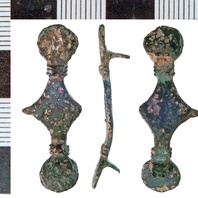
Viking Objects
Frankish Brooch (NLM-826868)
This copper-alloy brooch is either an equal-armed or ansate brooch. The ansate form is a Frankish style. It is possible that it made its way to England prior to Viking incursions but it is equally likely that the Vikings brought this brooch with them as plunder after raiding in Frankia. For more information on Scandinavian jewellery in England check out our blog: Brooches, Pendants and Pins: Scandinavian Dress Accessories in England.
Read More
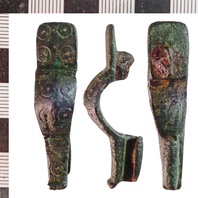
Viking Objects
Copper-Alloy Ansate Brooch (NLM-AED2E2)
The design of these brooches is a variant known as ‘caterpillar’ type which is typically geographically limited to areas bordering the North Sea, though the quantity found in England may indicate local manufacture. The original design of the brooch has a Carolingian origin. Ansate brooches are dated to between the seventh and ninth centuries though the finds at Coppergate in York may extend their popularity into the tenth century. It is possible that this particular example made its way to England prior to Viking incursions but it is equally likely that the Vikings brought this brooch with them as plunder after raiding in Frankia. For more information on Scandinavian jewellery in England check out our blog: Brooches, Pendants and Pins: Scandinavian Dress Accessories in England.
Read More
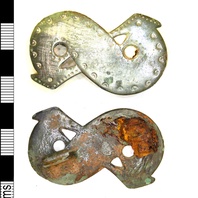
Viking Objects
Frankish Zoomorphic Brooch (LEIC-06202B)
The design of this brooch suggests that it was of Frankish manufacture and dates to roughly 600-700 AD. It is possible that it made its way to England prior to Viking incursions but it is equally likely that the Vikings brought this brooch with them as plunder after raiding in Frankia. For more information on Scandinavian jewellery in England check out our blog: Brooches, Pendants and Pins: Scandinavian Dress Accessories in England.
Read More
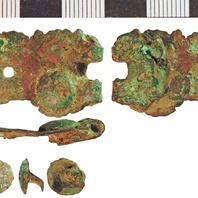
Viking Objects
Frankish Trefoil Buckle (NLM-60D592)
This cast copper-alloy buckle plate is trefoil in form and has traces of gilding which appear on the display side. The use of tripled domed rivets is similar to Frankish buckle styles introduced from the seventh century, while the use of gilding may relate this to eighth-century styles. It is possible that it made its way to England prior to Viking incursions but it is equally likely that the Vikings brought this buckle with them as plunder after raiding in Frankia.
Read More
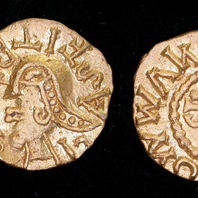
Viking Objects
Merovingian Tremissis (LEIC-6BAA60)
This Merovingian gold tremissis was minted in Bourges in the late 6th or 7th century. It is possible that it made its way to England prior to Viking incursions but it is equally likely that the Vikings brought this coin with them as plunder after raiding in Frankia.
Read More
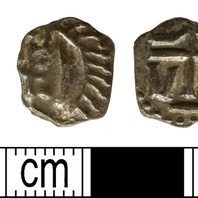
Viking Objects
Merovingian Denier (DENO-4A202A)
This is a silver denier produced by the Merovingian Franks around 700 to 750 at the mint of Marseille. It is possible that it made its way to England prior to Viking incursions but it is equally likely that the Vikings brought this coin with them as plunder after raiding in Frankia.
Read More
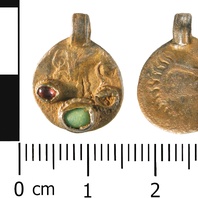
Viking Objects
Frankish Coin Pendant (WMID-24C235)
The coin that this pendant is made from was produced in North West France around 70-60 BC and is attributed to the Suessiones tribe. Later on the coin was adapted for use as a pendant and decorated with gilding and stone inlays. The colour and style of inlay give this pendant an early medieval dating and it is known that sometimes Iron Age coins were reused as pendants in Frankish jewellery. It is possible that it made its way to England prior to Viking incursions but it is equally likely that the Vikings brought this pendant with them as plunder after raiding in Frankia.
